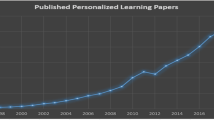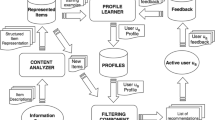Abstract
As it is difficult for learners to discover and obtain the most appropriate resources from massive education resources according to traditional keyword searching method, the context-aware based resource recommendation service becomes a significant part of pervasive learning environments. At present, recommendation mechanisms are widely used in e-commerce field, where content-based or collaborative-based filter strategies are usually considered separately. However, in these existing recommendation mechanisms, the dynamic interests and preference of learners, the access pattern and the other attributes of pervasive learning environments (such as multi-modes connecting and resources distribution) are always neglected. Thus, these mechanisms can not effectively reflect learners’ actual preference and can not adapt to pervasive learning environments perfectly. To address these problems, a context-aware resource recommendation model and relevant recommendation algorithm for pervasive learning environments are proposed. Therein, with taking into account the relevant contextual information, the calculation of relevant degree between learners and resources can be divided into two main parts: logic-based RRD (resource relevant degree) and situation-based RRD. In the first part, content-based and collaborative-based recommendation mechanisms are combined together, where the individual preference tree (IPT) is introduced to take into account the multi-dimensional attributes of resources, learners’ rating matrix and the energy of access preference. Meanwhile, the learners’ historical sequential patterns of resource accessing are also considered to further improve the accuracy of recommendation. In the second part, in order to enhance the validation of recommendation, the connecting type relevance and time satisfaction degree are calculated according to other relevant contexts. Then, the candidate resources can be filtered and sorted via combining these two parts to generate (Top-N) recommendation results. The simulations show that our newly proposed method outperforms other state of-the-art algorithms on traditional and newly presented metrics and it may also be more suitable for pervasive learning environments. Finally, a prototype system is implemented based on SEU-ESP to demonstrate the relevant recommendation process further.
Similar content being viewed by others
References
Weiser, M.: The computer of the 21th century. Sci. Am. 265(3), 66–75 (1991)
Schilit, B., Adams, N., Want, R.: Context-aware computing applications. In: Proceedings of IEEE Workshop on Mobile Computing Systems and Applications, pp. 85–90. Santa Cruz, California, December 1994
Packard, H.: Cooltown Project. http://www.cooltown.com/cooltown/index.asp (2004)
Dey, A., Salber, D., Abowd, G.: A conceptual framework and a toolkit for supporting the rapid prototyping of context-aware applications. Hum.-Comput. Interact. 16 (2001)
Mostefaoui, S.K., Bouzid, A.T., Hirsbrunner, B.: Using context information for service discovery and composition. In: Proc. of 5th International Conference on Information Integration and Web-based Applications and Services, pp. 129–138 (2003)
Roman, M., et al.: A middleware infrastructure to enable active spaces. IEEE Pervas. Comput. 1(4), 74–83 (2002)
Ryan, N., Pascoe, J., Morse, D.: Enhanced reality fieldwork: The context-aware archaeological assistant. Comput. Appl. Archaeol. (2007)
Yang, S.J.H.: Context aware ubiquitous learning environments for peer-to-peer collaborative learning. Educ. Technol. Soc. 9(1), 188–201 (2006)
El-Bishouty, M.M., Ogata, H., Yano, Y.: PERKAM: Personalized knowledge awareness map for computer supported ubiquitous learning. Educ. Technol. Soc. 10(3), 122–134 (2007)
Yang, S.J.H., Huang, A.F.M.: Context model and context acquisition for ubiquitous content access in U-Learning environments. In: Proceedings of the IEEE International Conference on Sensor Networks, Ubiquitous, and Trustworthy Computing (2006)
Li, L., Zheng, Y., Ogata, H., Yano, Y.: A framework of ubiquitous learning environments. In: Proceedings of the 4th International Conference on Computer and Information Technology (2004)
Ogata, H., Yano, Y.: Context-aware support for computer-supported ubiquitous learning. In: Proceedings of the 2nd IEEE International Workshop on Wireless and Mobile Technologies in Education (2004)
Yang, T.-C., Kuo, F.-R., Hwang, G.-J., Chu, H.-C., , A.: Computer-assisted approach for designing context-aware ubiquitous learning activities. In: IEEE International Conference on Sensor Networks, Ubiquitous, and Trustworthy Computing, pp. 524–530 (2008)
Syukur, E., Loke, S.W.: MHS learning services for pervasive campus environment. In: Proceedings of the 4th IEEE International Conference on Pervasive Computing and Communications Workshops (2006)
Siobhan, T.: Pervasive, persuasive eLearning: modeling the pervasive learning space. In: Proceedings of the 3rd IEEE International Conference on Pervasive Computing and Communications Workshops (2005)
Rogers, Y., Price, S., Randell, C., Fraser, D.S., et al.: Ubi-learning integrating indoor and outdoor learning experiences. Commun. ACM 48(1), 55–59 (2005)
Joiner, R., Nethercott, J., Hull, R., Reid, J.: Designing educational experiences using ubiquitous technology. Comput. Human Behav. 22(1), 67–76 (2006)
Adomavicius, G., Tuzhilin, A.: Toward the next generation of recommender systems a survey of the state-of-the-art and possible extensions. IEEE Trans. Knowl. Data Eng. 17(6) (2005)
Mostafa, J., Mukhopadhyay, S., Lam, W., Palakal, M.: A multilevel approach to intelligent information filtering: model, system, and evaluation. ACM Trans. Inf. Syst. 15(4), 368–399 (1997)
Pazzani, M., Billsus, D.: Learning and revising user profiles: the identification of interesting web sites. Mach. Learn. 27, 313–331 (1997)
Chen, L., Sycara, K.: WebMate: a personal agent for browsing and searching. In: Proceedings of the Second International Conference on Autonomous Agents (1998)
Chen, C.C., Chen, M.C.: PVA: a self-adaptive personal view agent. J. Intell. Inf. Syst. 18(2/3), 173–194 (2002)
Wang, J., de Vries, A.P., Reinders, M.J.T.: Unifying user-based and item-based collaborative filtering approaches by similarity fusion. In: Proceedings of the 29th International ACM SIGIR Conference on Information Retrieval (2006)
Ma, H., King, I., Lyu, M.R.: Effective missing data prediction for collaborative filtering. In: Proceedings of the 30th International ACM SIGIR Conference on Information Retrieval (2007)
Sarwar, B., Karypis, G.: Item-based collaborative filtering recommendation algorithms. In: Proceedings of the 10th International Conference on World Wide Web (2001)
Ziegler, C.N., McNee, S.M., Konstan, J.A.: Improving recommendation lists through topic diversification. In: Proceedings of the 14th International Conference on World Wide Web (2005)
Adomavicius, G., Sankaranarayanan, R.: Incorporating contextual information in recommender systems using a multidimensional approach. ACM Trans. Inf. Syst. 23(1) (2005)
Deshpande, M., Karypis, G.: Item-based Top-N recommendation algorithms. ACM Trans. Inf. Syst. 22(1), 143–177 (2004)
Linden, G., Smith, B., York, J.: Amazon.com recommendations: Item-to-item collaborative filtering. In: IEEE Internet Computing, pp. 76–80, January–February 2003
Claypool, M., Gokhale, A., Miranda, T., Murnikov, P., Netes, D., Sartin, M.: Combining content-based and collaborative filters in an online newspaper. In: Proceedings of the ACM SIGIR’99 Workshop on Recommender Systems: Algorithms and Evaluation
Billsus, D., Pazzani, M.: User modeling for adaptive news access. User Model. User-Adapted Interact. 10(2–3), 147–180 (2000)
http://www.celtsc.edu.cn/. Accessed 20 January 2009
Pei, J., Han, J., Mortazavi-Asl, B., Pinto, H.: PrefixSpan: Mining sequential patterns efficiently by prefix-projected pattern growth. In: Proceedings of the IEEE 17th International conference on Data Engineering, pp. 215–226 (2001)
http://movielens.umn.edu/. Accessed 20 January 2009
Author information
Authors and Affiliations
Corresponding author
Rights and permissions
About this article
Cite this article
Luo, J., Dong, F., Cao, J. et al. A context-aware personalized resource recommendation for pervasive learning. Cluster Comput 13, 213–239 (2010). https://doi.org/10.1007/s10586-009-0113-z
Received:
Accepted:
Published:
Issue Date:
DOI: https://doi.org/10.1007/s10586-009-0113-z




